Photographs by Jim Stiles, unless otherwise noted
In the late 1950s, Bates Wilson was the superintendent of Arches National Monument. The new paved road to Balanced Rock had recently been completed, and with the easier access, Bates saw a disturbing and related trend. The easier the access, the more visitors…and with more visitation, damage to the natural resources of the park increased as well. Jeepers, driving off designated roads was a problem, but the one violation that really got Bates’s crawl was the increase in grafitti. Every damn visitor to the park seemed determined to immortalize themselves by scratching their names in the rock. And most of the time, the tourists chose the most iconic features of the monument to deface. It was incredibly stupid, when you think about it. They were inscribing their own names, and sometimes even their city of origin on the entrada sandstone. It was as if they were trying to help with the investigation. And often, when it was a local, their own narcissism led to a heavy fine.
In those days, superintendents filed a monthly report of the monument’s activities; I’ve published many of them in The Zephyr. But in one report, Bate’s anger flowed on to the pages of his report like hot lava. He wrote:
“The increasing desire of fools to carve their names in public places has reached the highest level possible in Arches; Delicate Arch. A list of the new names found was made and an attempt to run a bluff by letter will be made with those whose address we have, but to get conclusive evidence we sill have to catch them in the act.“
Still the problem with defacing the sandstone walls of entrada sandstone ay Arches, and other parks across the country, remains, from coast to coast. Last year the media reported an increasing number of vandalized sites at places like Yosemite, where more than 30 locations, apparently done by the same vandal, were damaged. In 2022 tourists reported two young men defacing a rock near one of the Grand Canyon’s most scenic overlooks. The tourists yelled at them to stop, but the teenagers paid no attention. The graffiti was reported and Park Rangers opened an investigation, but seldom do they catch the two culprits, who one witness to their crimes as “absolute idiots.”
It continues to be a growing problem as tourism visitation swells every year, bring more “idiots” to these special places than malevolent vandals. It’s like comparing ‘ignorant idiots’ to ‘evil idiots.’ I’m honestly not sure which is worse. The result is the same.
WHEN (and why) GRAFFITI BECAME PRICELESS ART
Of course, not all “graffiti” is or was the work of vandals. There was a time when the only means of expressing oneself artistically, or to simply tell a story, was to use the smooth flat sandstone walls and whatever pigments or implements they could find to express themselves. Though most all of you know this, for the beginners, a petroglyph is an image that has been chiseled into the rock. “Desert varnish,” where minerals have stained the sandstone over eons of time, is much darker—the perfect “petroglyph canvas.” A pictograph is truly painted on the wall. Native Americans discovered different plants that produced colors of various intensities and shades. Both images below, the Harvest Scene and the Great Gallery are two of the most perfect examples. They are scattered across the North American continent, but are especially prolific, and priceless in the American Southwest, and especially in the canyons and cracks of the Colorado Plateau.
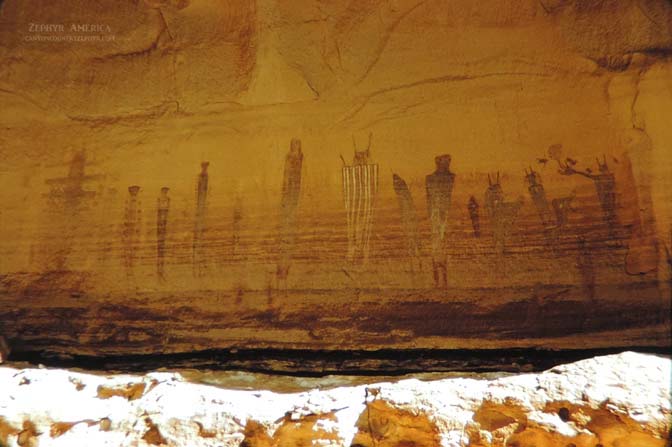
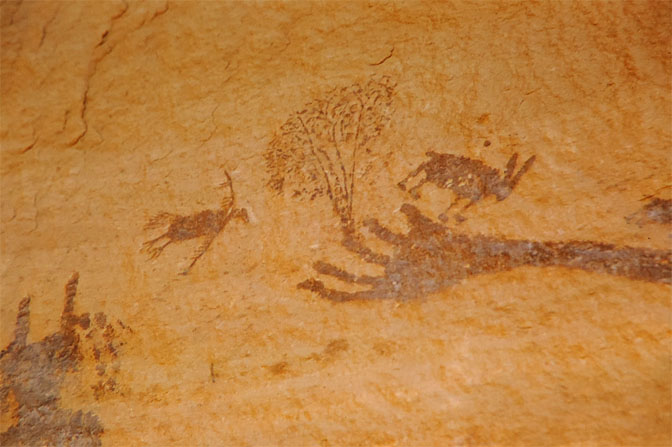
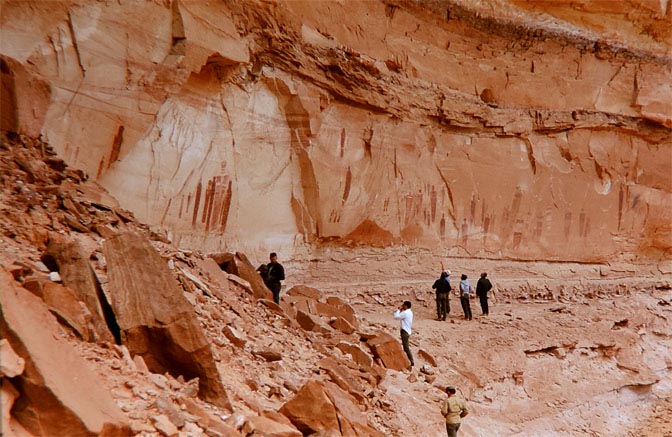
THE MOAB PANEL…BEFORE & AFTER
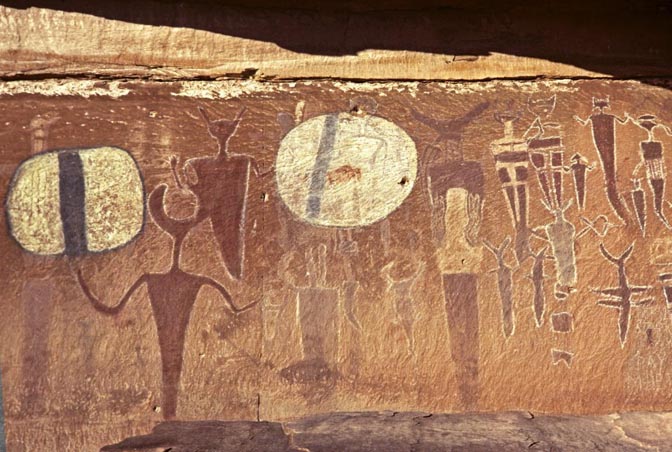
During the night, a person or persons, had walked the 100 yards as well, with buckets of water and what appeared to be wire brushes. They proceeded to scour the famous “Moab Panel” from existence. I took these photos later in the afternoon of the same day. In addition to the extreme vandalism to the panel, an epithet had been scratched into the rock boulder below it. The crime was so extreme that agents from the FBI office in Salt Lake City came to Moab and worked with local law enforcement and Arches Unit Manager Larry Reed to find those responsible. Though there was never any resolution—no one was prosecuted— the investigation took the FBI and Reed all the way south to the Navajo reservation. There were scattered rumors of a feud between two adversarial Navajo families and the vandalism had, according to one Navajo witness, represented an effort to place a “curse” on those enemies. Later Reed told me that the investigation took them to the Hogan of a Navajo elder. It was rumored that she knew who had done the damage. But she would not speak of the incident. The case has never been solved.
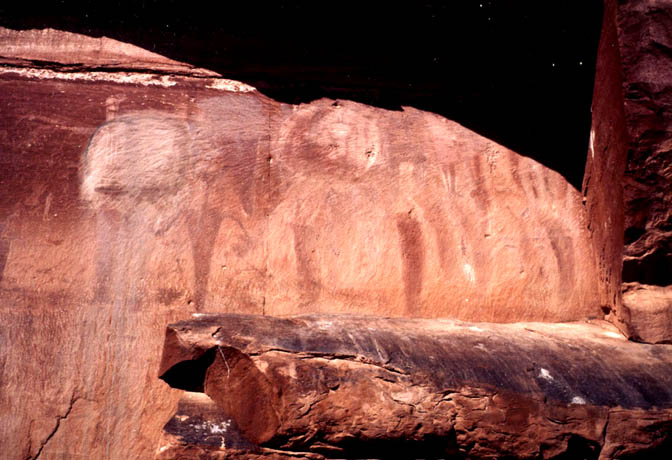
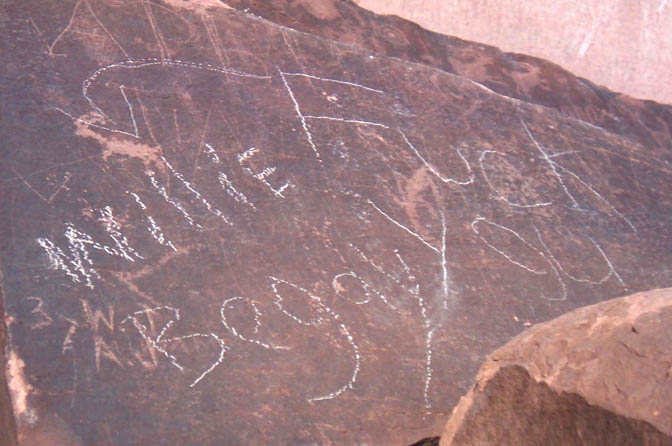
LATER INSCRIPTIONS…HISTORICALLY SIGNIFICANT? OR JUST MORE VANDALISM?
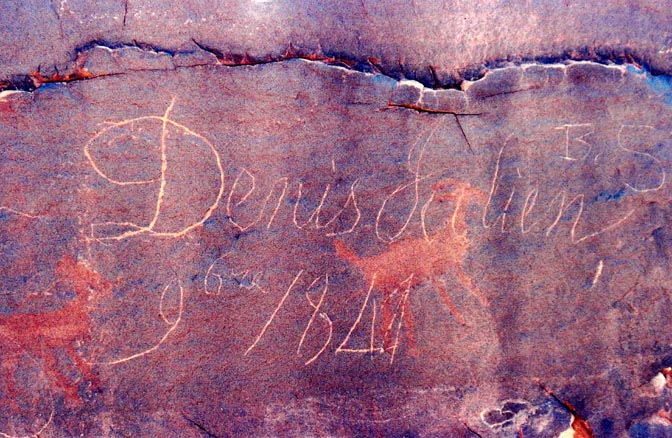
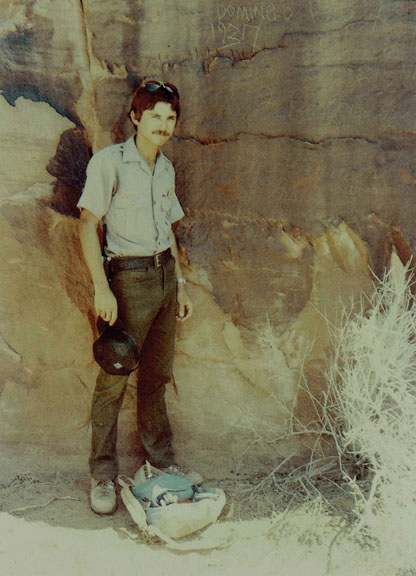
But when does a carved name on a rock stop being vandalism and take on a historic value of its own? Where do we draw the line? A century? Fifty years? I struggled with that question a lot when I was a ranger, though over the years, I came to believe that every one of these carvings is too special to be removed.
The above inscription has special meaning for me, because I found it during a backcountry patrol in 1977. It would be fairer to say I “re-found” it, many years after other humans, most likely Basque sheepherders, had added their own names and comments (whether the ‘B.S.’ next to Julien’s name was an expression of doubt re: the inscription’s authenticity, of it just happened to be the man’s initials, the Julien inscription had surely been seen. but perhaps decades earlier.
I stumbled upon it purely by accident, toward the far north end of the Devils Garden. I saw the Basque inscriptions first and noticed that it was a perfect campsite. It was at the base of a small natural amphitheater—the sandstone tower and fins blocked the weather coming from the north or east. A fifty foot stabilized dune to the west of the site protected campers from the western winds. It was only after I stood directly in front of these larger inscriptions that I noticed Julien’s name. I had heard it before and thought it was worth writing up a report on my find. I had no idea it would create so much interest.
A couple days later, my boss, Chief Ranger Jerry Epperson, read my report and was interested enough to contact historian John Hoffman. John was from California but was fast becoming one of the region’s most respected historians. I showed Hoffman the photos and he was convinced it was genuine. Hoffman was a close friend of the legendary river runner/historian Dock Marston. Marston was ecstatic. Though Marston’s physical health was failing, Dock booked a flight to Moab the next week. He was not healthy enough to make the rugged six mile round trip, especially in July, so he impatiently waited for Hoffman and I to return from the walk.
It was Hoffman’s first eyes-on visit and he almost immediately proclaimed it genuine. What made the discovery particularly interesting was that Julien had been known to leave his signature at various locations in the canyon country. But they had stopped in the late 1830s, and there was an assumption that Julien had drowned in the Green River in 1836. Hoffman took a Polaroid camera with him so that he could show Dock pictures as soon as we returned to the Devils Garden Trailhead. We found Dock pacing beside his car, waiting for us. As much as he paced, he may have walked further than we did. But Dock studied the images and declared them to be authentic. Years later, a voters roll list for St. Louis showed a signature almost exactly like the one I had found. It was Julien for sure…
THE ROBIDOUX INSCRIPTION

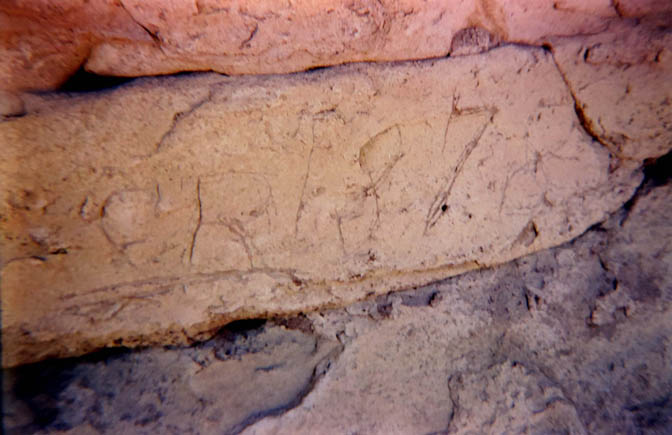
During my first winter at Arches, as a volunteer at the old Arches visitor center, I had a lot of time to read the old monthly reports (The Zephyr has posted many of them over the years). I recalled one reference to an inscription that Ranger Abbey had come upon in 1956. He noted that it was inside a small arch in the Devils Garden and noted the inscription. He wrote that it said: “RC 1876.” When I found this years later, I was sure it was the same inscription—Abbey had just flipped the numbers and letters. It had been a very hot day.
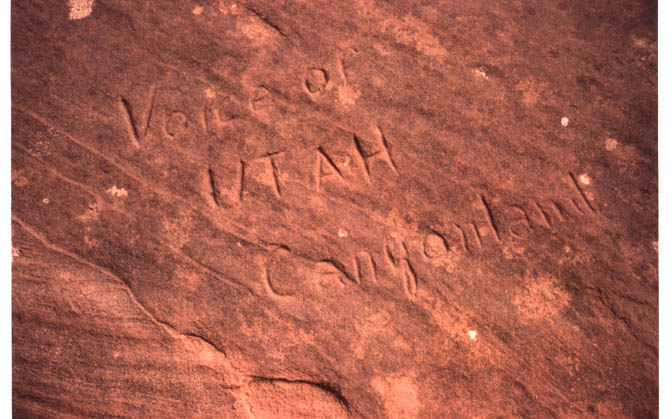
All I can tell you is that Reuben Scolnik and I found this purely by accident, after exiting our 4WD and wandered into the brush looking for an appropriate place to relieve ourselves. This inscription, and the one at the very ‘end’ of this post were within a few feet of each other. We found no other evidence of human beings having been there lately.
THE DEVILS GARDEN INSCRIPTIONS
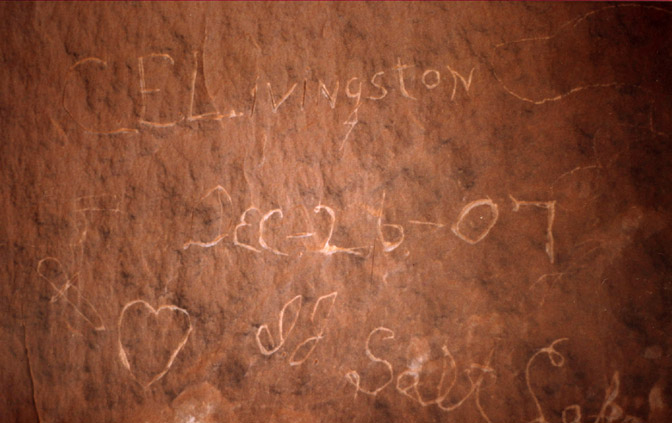
I was wandering in the northern end of the Devils Garden, when I came across a wide meadow, surrounded by Entrada sandstone fins and towers, To the west the land arose to the far west ridge of the Devils Garden before it descended into Salt Valley. By now I had learned to recognize good pasture and excellent camps for the men who cared for their livestock. It didn’t take long to find a series of carved names and dates, going back to the 1930s, Dominguez— whoever he was — wandered Arches from one end to the other.
But one inscription, further north caught my eye and I cliimbed the talus below it for a better look. Two names had been etched into the sandstone:
C.E. Livingstone
Dec-26-1907 I.J Salt Lake
To the left of the date was a dagger and beside it, a heart. I had no idea what it meant. And I was struck by the date: December 26, 1907. The day after Christmas on what must have been a cold and bitter winter day.
To the right of Livingston’s inscription was another name. Again a heart with a dagger through it was carved first. The best I could come up with was:
E. EMIG
J.HP. HARUMS
Dec 26 1907
Who were these guys? Did “E. Emig” refer to Emigration Canyon in Salt Lake City? Why were they in a remote corner of one of the most inaccessible parts of an area so rugged and unknown, that it would not become a part of Arches National Park for almost 70 years? It’s a mystery to be sure. Is this graffiti? I hope not.
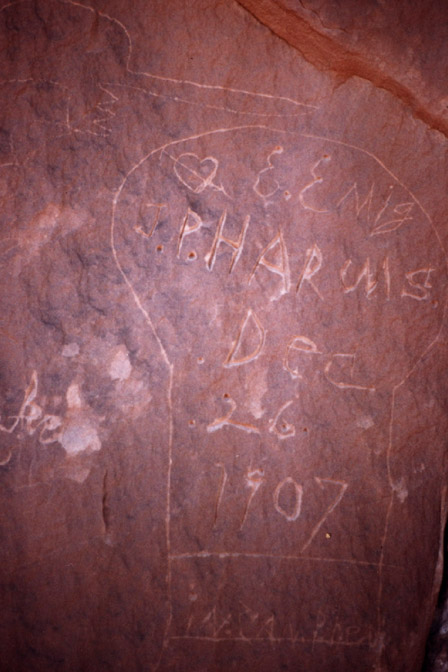
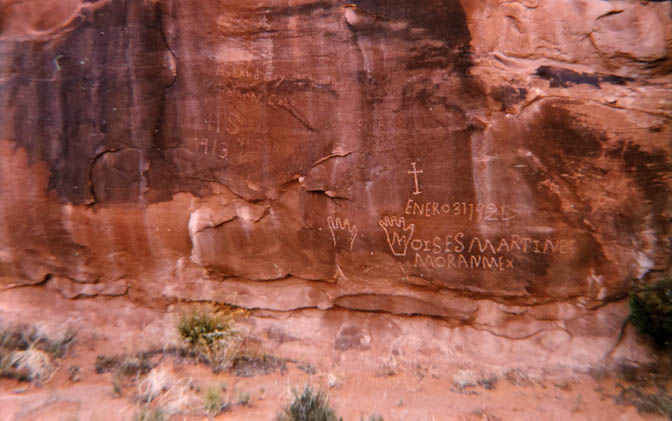
THE L.R MESTAS INSCRIPTIONS
It occurred to me years ago, as I came to see more and more of these inscriptions, that while many of them represented backcountry camps for cowboys and sheepherders, many more might be found along the main thoroughfares, as travelers moved across this rugged and unforgiving country. Until the 1940s most of the highways we take for granted now, were just dirt, or at best, gravel roads. Consequently trips from Monticello to the railhead at Thompson could take days. Even the 55 mile drive to Moab could be an overnighter.
So about 20 years ago, I started looking for what I called “roadside history.” I kept an eye out especially for sandstone walls that were the kind of ‘canvas’ that lonely cowboys and sheepmen might seek out as they idled away the time in what was one of the most lonely spots in North America. Much of what you see in the following images are quite close to US 191, but are rarely noticed, much less acknowledged for their historical significance.
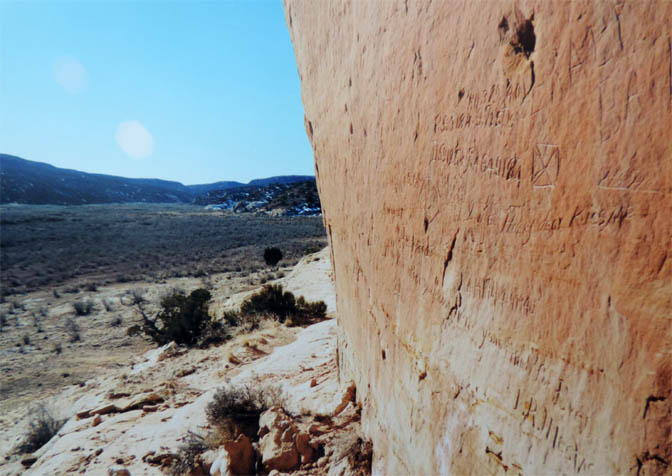
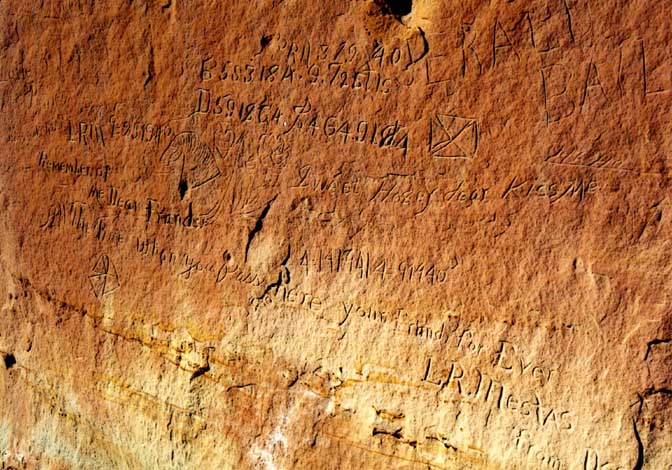
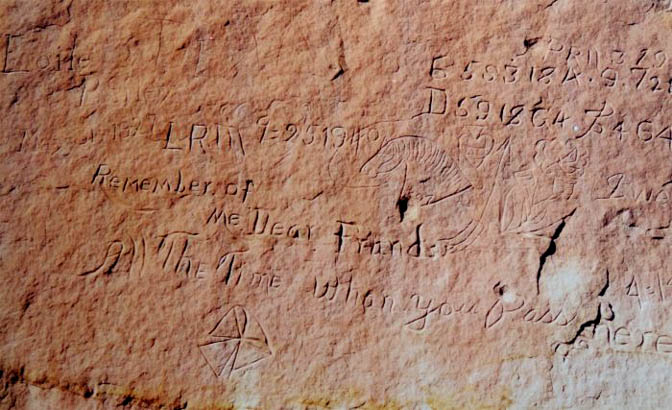
“Remember me dear friends all the time when you pass here. Your friend.
L.R. Mestas September 25, 1940
Durango, Colorado
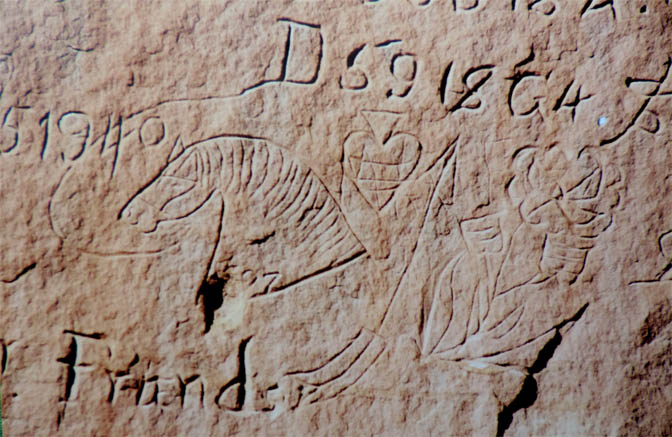
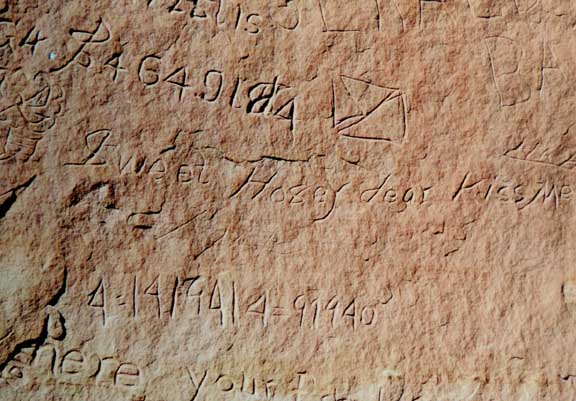
“Sweet Hosey dear Kiss me.”
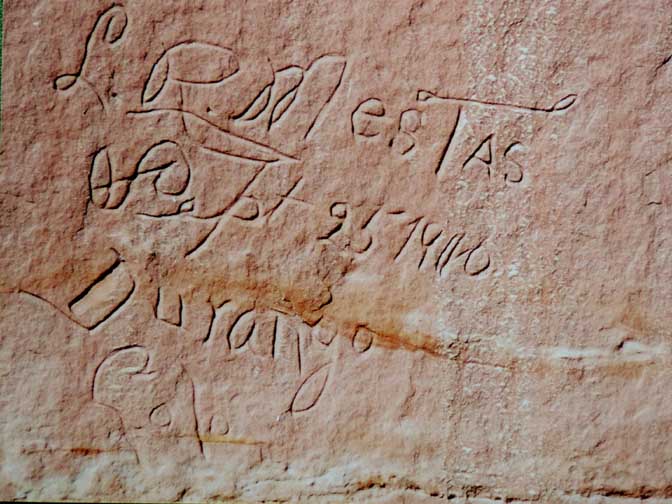
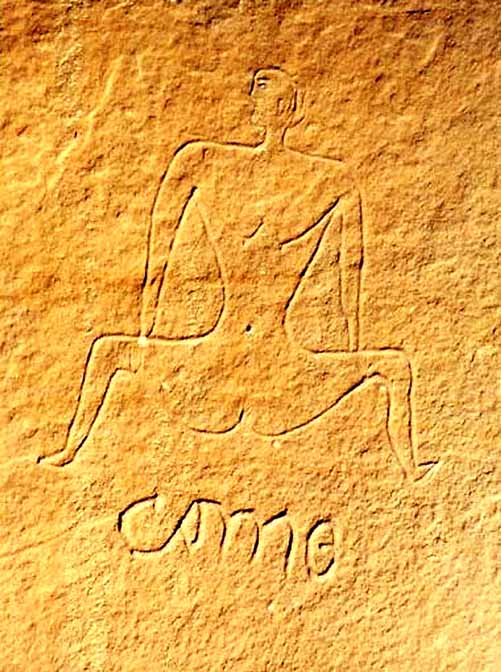
THOSE SIGNATURES (& ART) WHERE YOU LEAST EXPECTED IT.
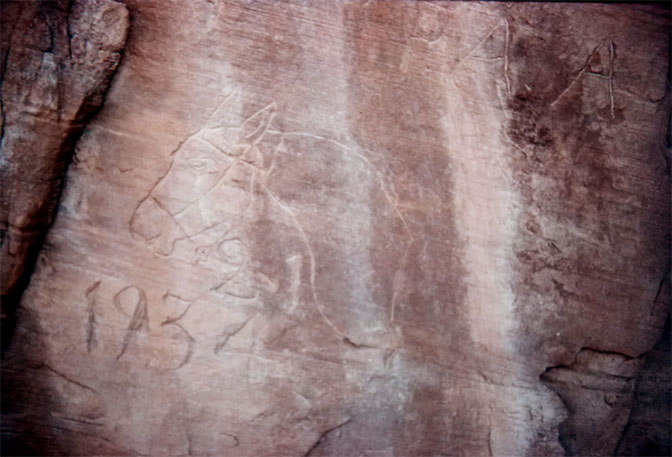
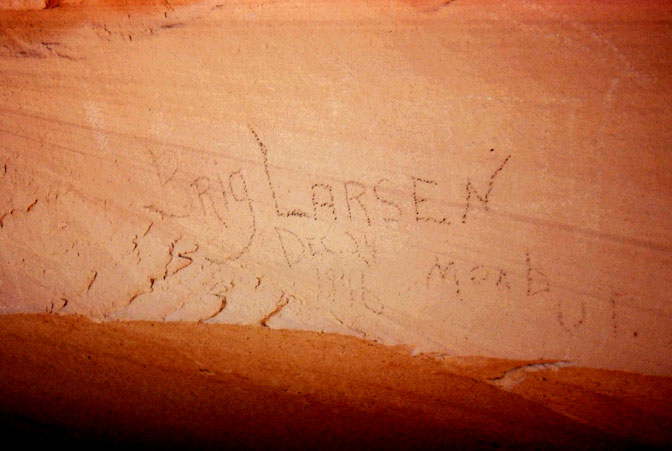
“Dell Taylor, January 10, 1929”
Dell was another lifelong Moabite and though I never met him, I remember showing the photo to an NPS friend of mine at park headquarters, Kate Juenger. She laughed and said, “Dell Taylor is my next door neighbor.” She lived on 100 North in Moab in 1978 and was his good friend and ‘helper’ from time to time.
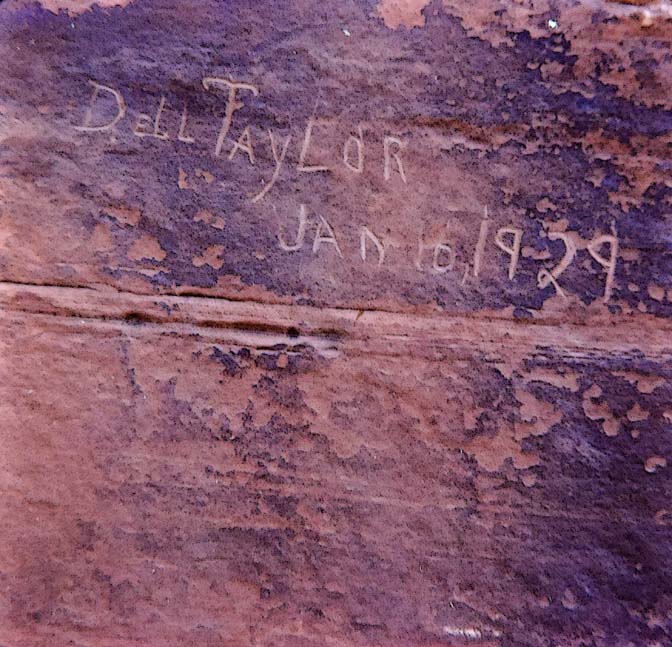
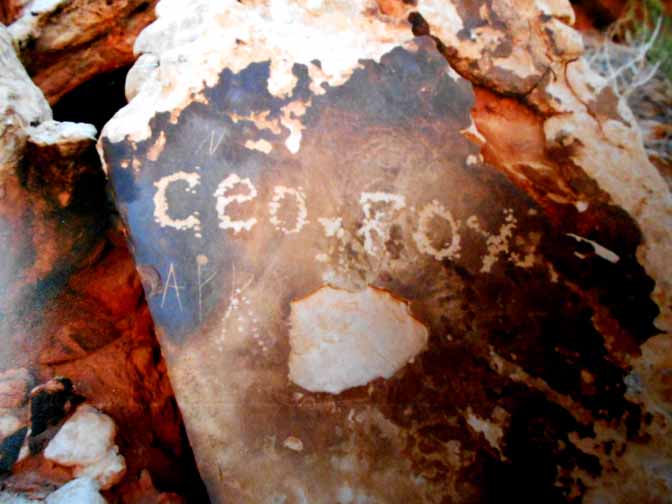
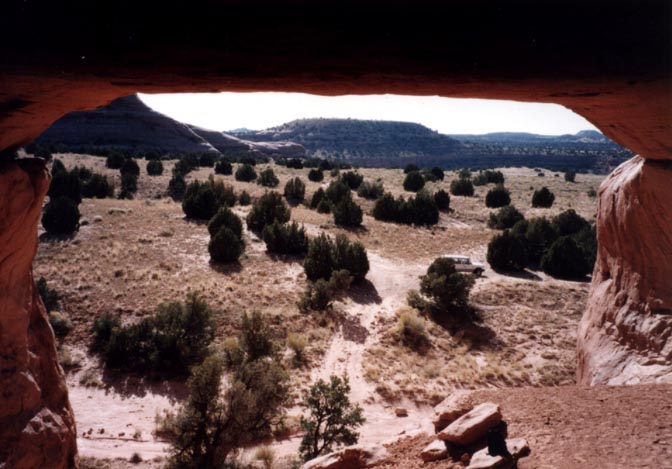
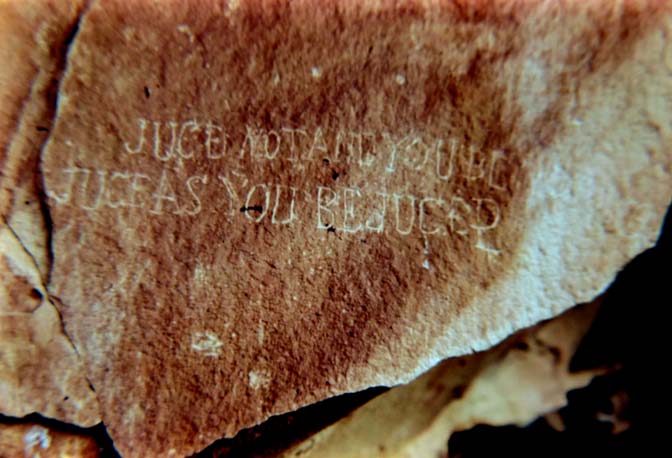
“JUGE NOT AND YOU BE (NOT JUGE?)
JUGE AS YOU BE JUGED.“
THE UNITY MONUMENT
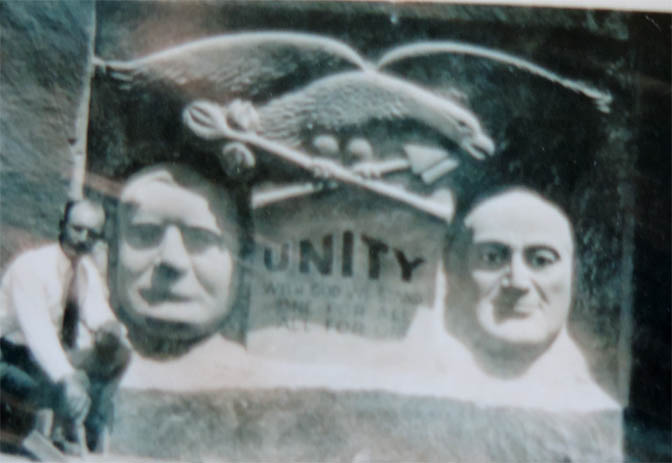
I wrote a long story about the Unity Monument and won’t try to repeat it here. Better to leave a link to the story: Click here , But briefly, Albert Christensen, the man who created “Hole n” the Rock, south of Moab, was inspired to honor BOTH of the presidential candidates in 1940. For once, Albert thought, we have TWO decent patriotic Americans running for the nation’s highest office– Franklin D. Roosevelt & Wendell Willkie. Christensen wanted to honor both men and the scale of his proposal rivaled Mt Rushmore. But first he sculpted a miniature of the Unity Monument, so people could share his dream with him. The photo above is Christensen with his finished scale model. But the federal government, according to reports in the Moab Times-Independent, took issue with the plan and claimed that Albert didn’t have permission to even sculpt the miniature. Below is what the government agents did to Albert’s dream. Some say this was the first real incident that created the tensions that exist between local citizens in the West and the federal government, even to this day. Note, the photo below was taken in the early 2000s. I’d guess it still looks like this…
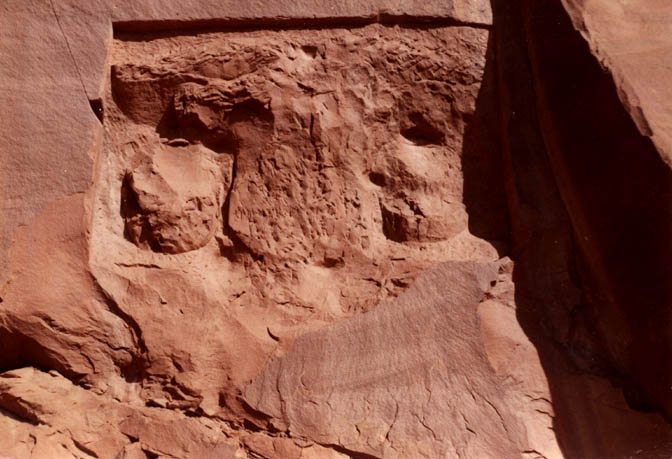
KING OF AMERICA/KING WORLD
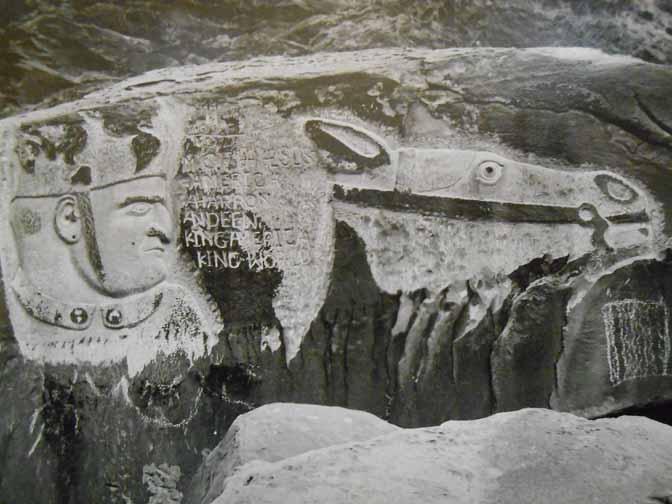
Then in 2020 author Jen Quintano made an amazing breakthrough. Her research still amazes me and I have no idea where or how she was able to find so much history about this abused and forgotten man. The Zephyr published a two part series by Jen. You can read them here and here. It was bad timing in one sense. Her story appeared here just days after the outbreak of the Covid-19 Pandemic. And as we all know, for months, few paid any attention to anything not related to the Covid. I have not heard from Jen in years but I hope she is working on a book. This story and her research deserve to be shared.
(The sculpture was removed from its original location about twenty years ago, and now resides in Moab, in front of the senior center,)
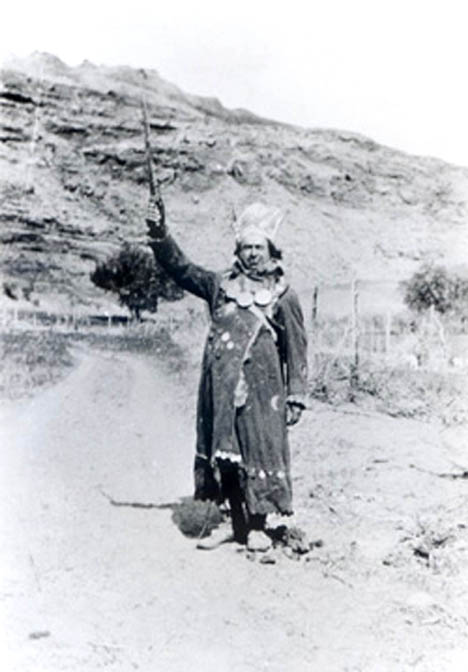
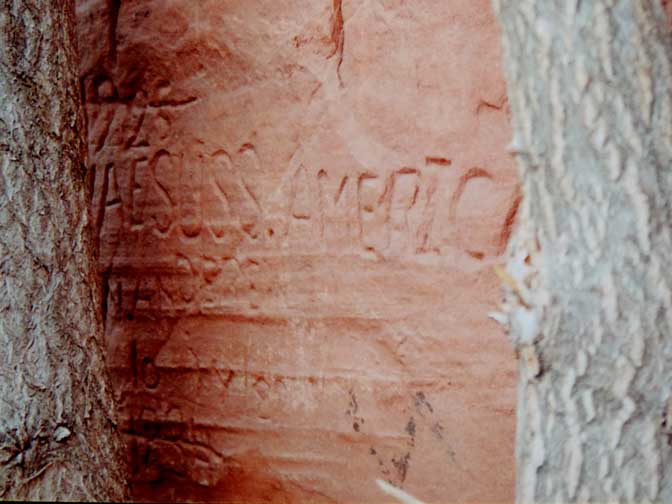
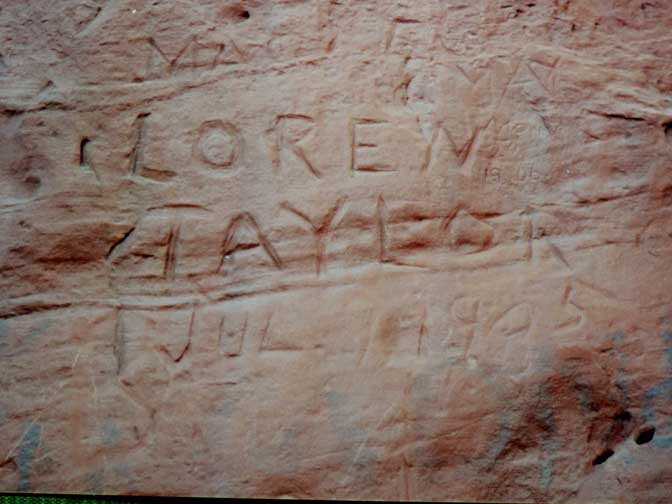
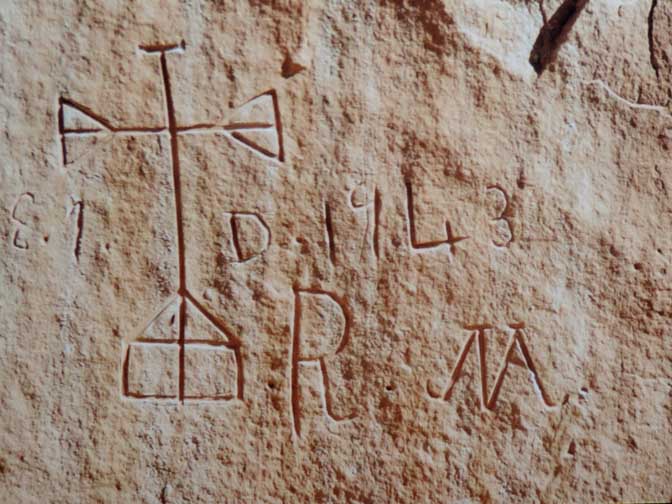
NOT ALL MEMORABLE INSCRIPTIONS ARE CARVED IN ROCK
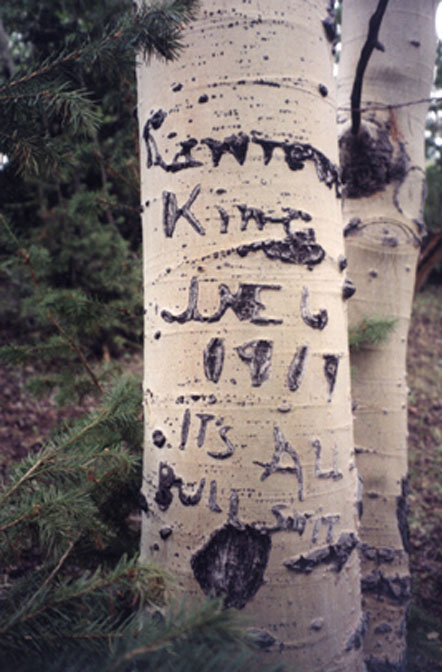
LAWRENCE KING
JUNE 6 1917
IT’S ALL BULLSHIT
AND THE MOST RECENT GRAFFITO THAT HAS AN HISTORIC VALUE
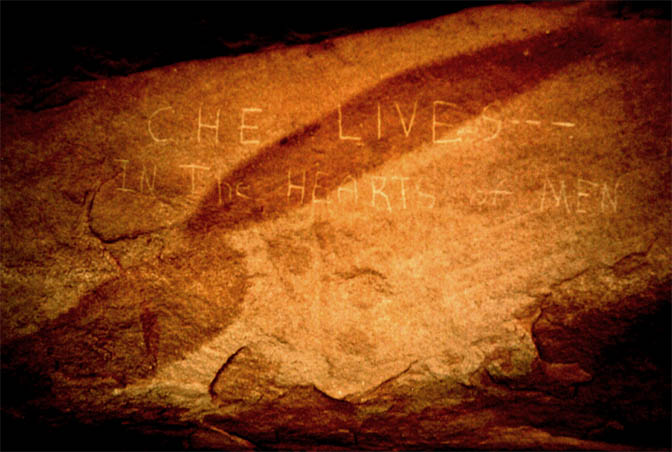
ED ABBEY’S SIGN AT ARCHES
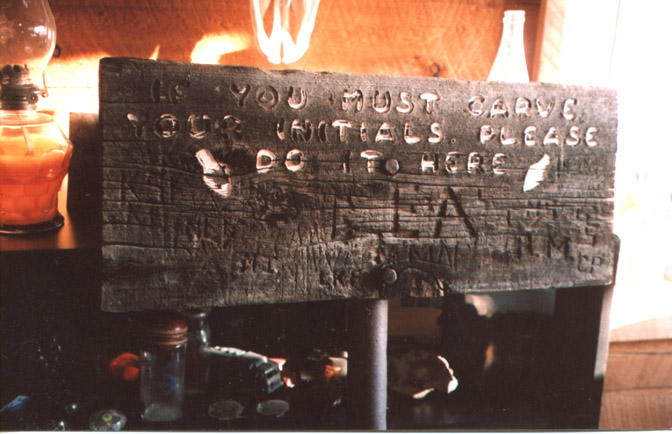
But as I wandered farther from the area, something metallic caught my eye. Buried in sand and covered mostly by blackbrush and sage was a sign…this sign. Despite the fact that it had been tossed here almost twenty years earlier, some of the white paint still remained in the routed letters. To me letting it lie here and rot would have been a crime, so I picked it up, put it in the park carry-all, and took it back to the Devils Garden trailer. I showed it to my bosses; nobody seemed to want it, so I cleaned it up as best I could and eventually placed it in front of my old cabin down in San Juan County.
One day I heard a truck pull up. It was Abbey. I saw him climb out of his smashed up Ford pickup truck and walked toward the door. Suddenly he stopped short. He was staring at the sign. The famous Ed Abbey furrowed brow was more furrowed than usual. Finally he looked at me and said, “Stiles, where the hell did you find this?” I explained the story.
Abbey replied, “I remember this sign.” He paused for a moment. “Wait a minute…I MADE this sign!” His frustration with the graffiti scribblers was just as intense as his boss. Abbey decided that maybe…just maybe…if he provided the tourists with another medium upon which to scribble their names, he might divert them from the rock.
“Did it work?” I asked. “What do you think?” he grinned. Abbey left to visit his buddy John DePuy, who also owned some land out there. And I had to get back to Arches. But when I returned a week later, I noticed a new inscription on that very old sign. You can hardly miss the “EA” that Cactus Ed carved.
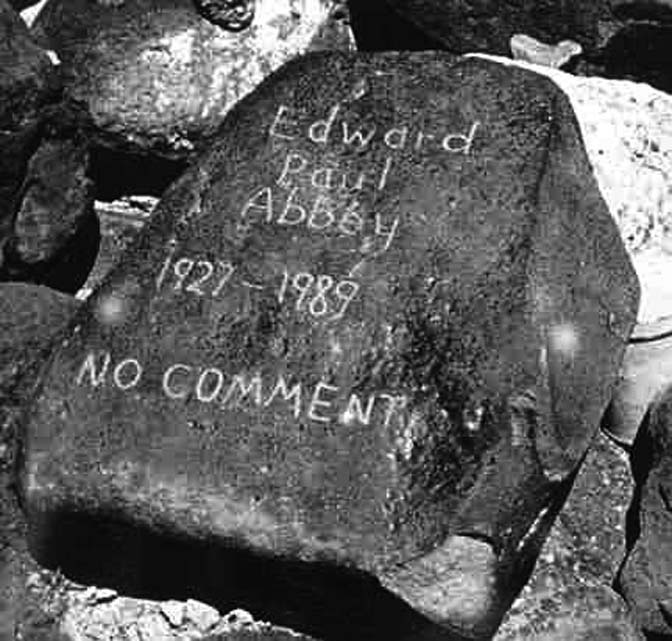
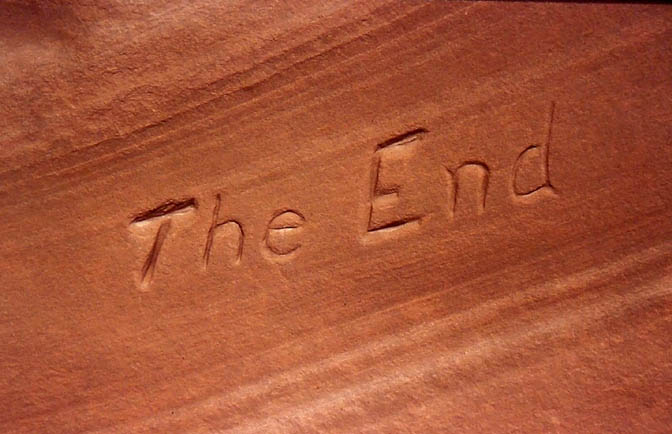
So the question remains…when do these carvings become priceless artifacts of history? And when are they the work of fools? Or…if you give it enough enough time, is it possible to move from vandal to documentarian? I welcome your comments. Down below…

Jim Stiles is the publisher and editor of The Zephyr. Still “hopelessly clinging to the past since 1989.” Though he spent 40 years living in the canyon country of southeast Utah, Stiles now resides on the Great Plains, in a tiny farm and ranch community, Coldwater, Kansas, where there are no tourists.
He can be reached via facebook or by email: cczephyr@gmail.com
TO COMMENT ON THIS STORY & THESE IMAGES, PLEASE SCROLL TO THE BOTTOM OF THIS PAGE.

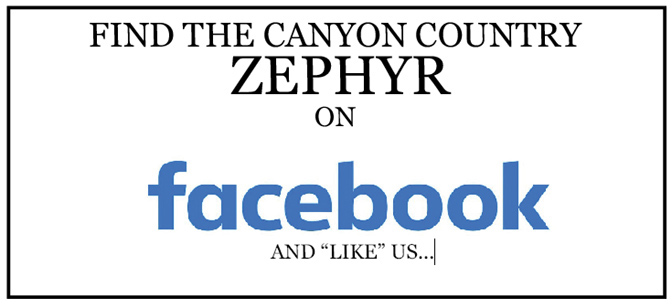
And I encourage you to “like” & “share” individual posts.
Why they can’t just leave the site alone is beyond me,
but that’s what Facebook likes to do.
ALSO NOTE: I post old photographs and stories from our 25 year old archives every day. Pictures from Herb Ringer, Edna Fridley, Charles Kreischer.. even a few old photos from my Dad. So if you want to stay caught up on our historic photo collections,
be sure to “follow” us on Facebook…Thanks…Jim
https://www.facebook.com/FansoftheCanyonCountryZephyr/
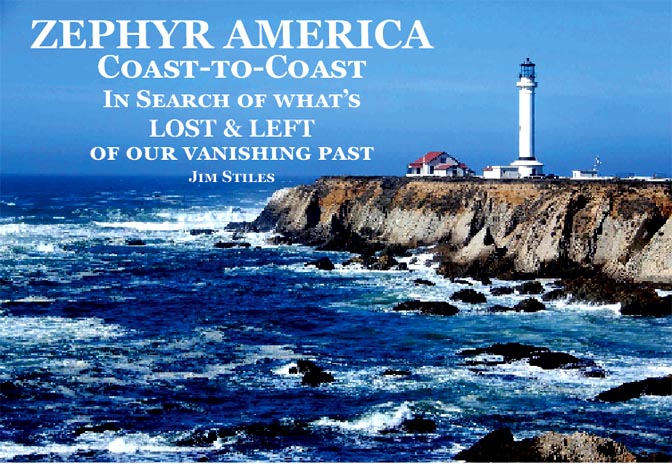
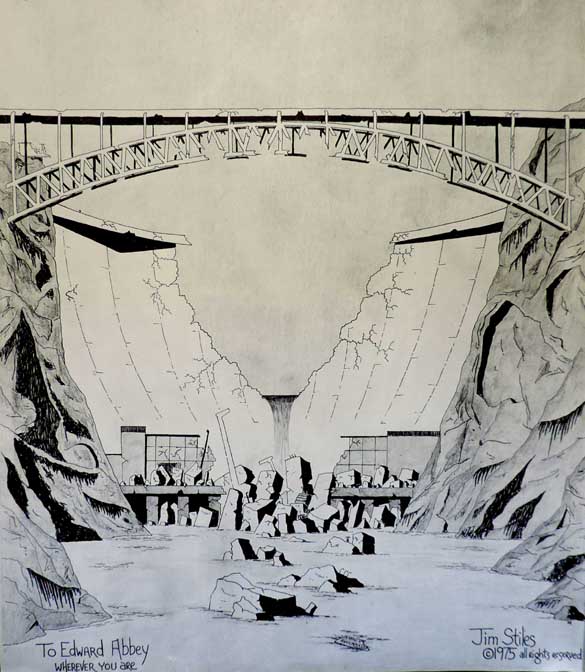
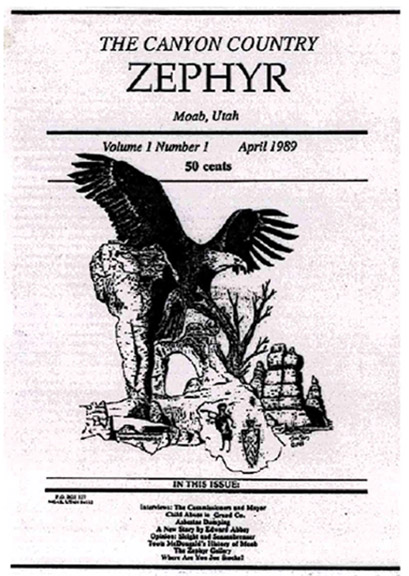
Signed copies…

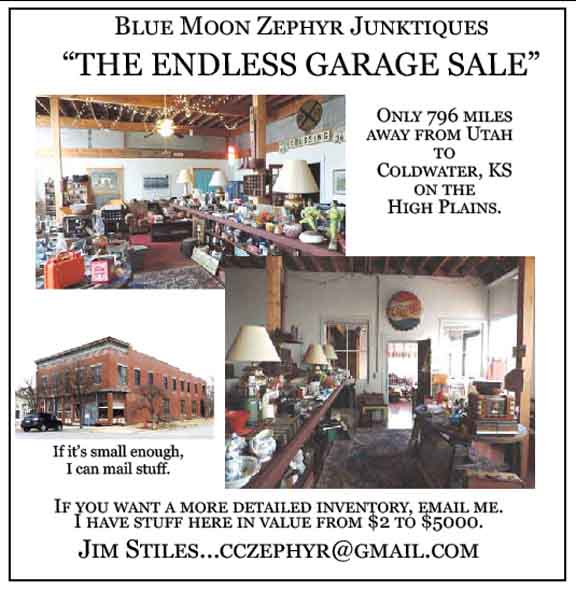
https://www.facebook.com/profile.php?id=100086441524150
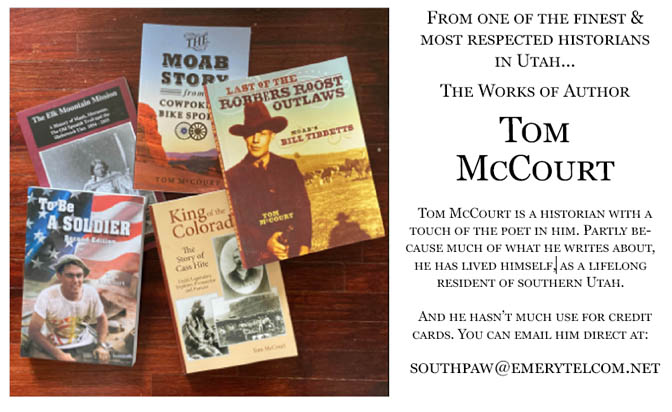
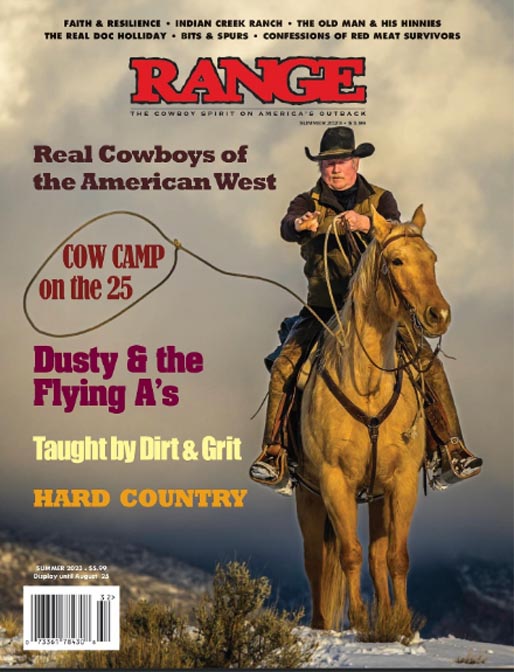
NOTE: The summer issue of RANGE includes a tribute to lifelong Moabite Karl Tangren

And check out this post about Mazza & our friend Ali Sabbah,
and the greatest of culinary honors:
https://www.saltlakemagazine.com/mazza-salt-lake-city/
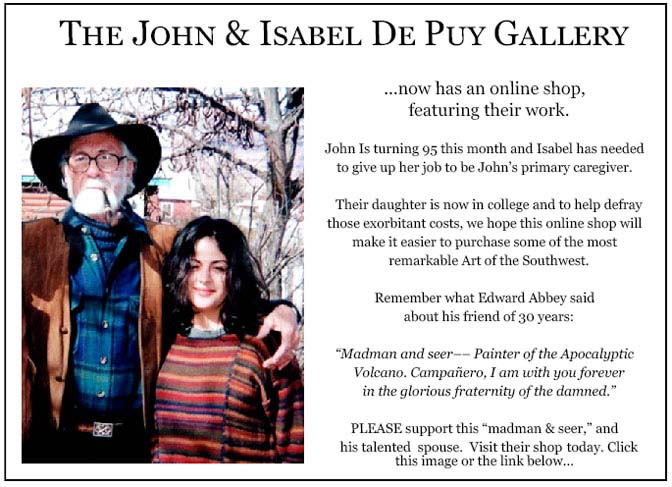
More than six years ago, The Zephyr, me & four other individuals were sued for defamation by the former Moab City Manager. Faced with mounting legal bills, my dear friends John and Isabel De Puy donated one of John’s paintings to be auctioned.
ALL the proceeds went to our defense.
Thanks to them, our bills were almost completely covered.
Now I’d like to return the favor. Check out the link below and their online shop… JS
https://www.depuygallery.com/shop.html

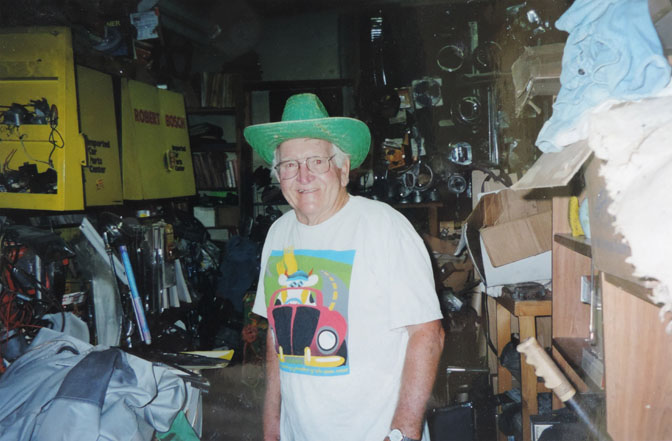
https://www.canyoncountryzephyr.com/2023/07/30/tom-arnold-moabs-vw-mechanic-philosopher-ed-abbeys-pilot-zx73-by-jim-stiles/
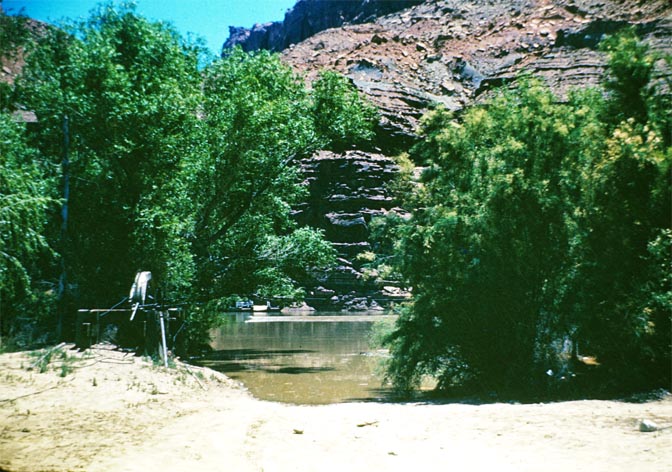
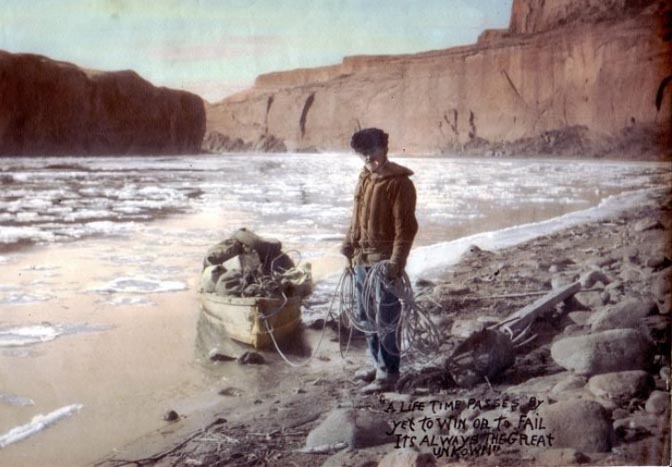
https://www.canyoncountryzephyr.com/2023/07/13/january-1931-the-strenuous-life-by-harvey-leake-zx71/
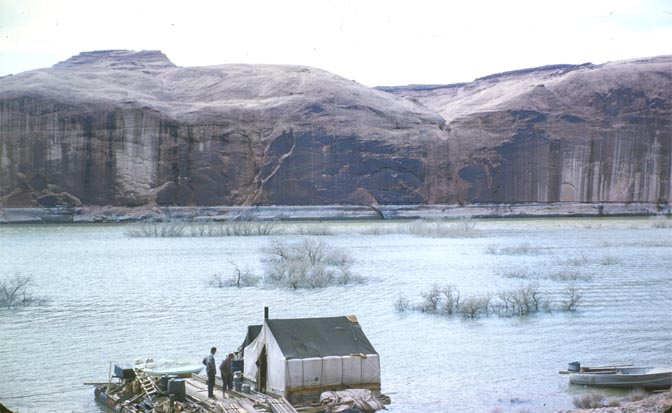
https://www.canyoncountryzephyr.com/2023/07/22/1963-64-glen-canyons-last-days-w-hites-beth-ruben-nielsen-zx72/
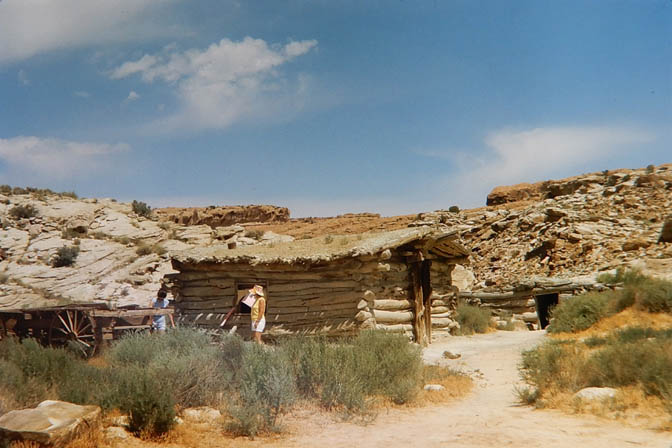
https://www.canyoncountryzephyr.com/2023/07/02/should-arches-wolfe-ranch-be-re-renamed-turnbow-cabin-jim-stiles-zx69/
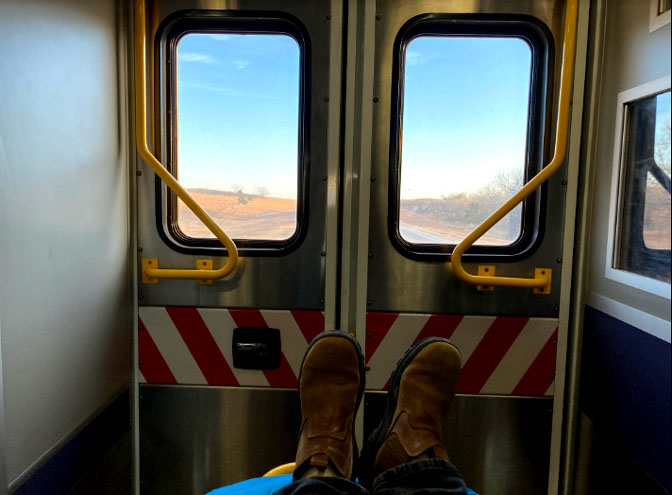
https://www.canyoncountryzephyr.com/2022/08/07/grief-meets-orwell-the-cuckoos-nest-by-jim-stiles-my-recent-encounter-with-the-mental-health-industry-zx20/

https://www.canyoncountryzephyr.com/2023/06/25/searching-for-klatu-my-ufo-vacation-jim-stiles-zx68/
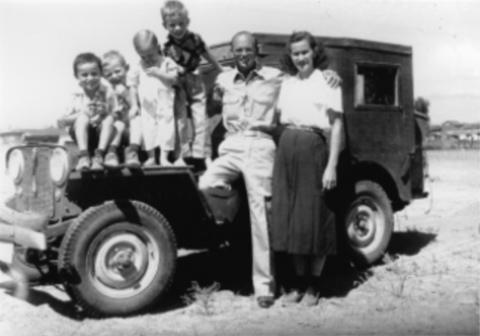
https://www.canyoncountryzephyr.com/2023/06/18/moabs-other-wild-ride-charlie-steens-1950s-uranium-boom-by-maxine-newell-zx-67/
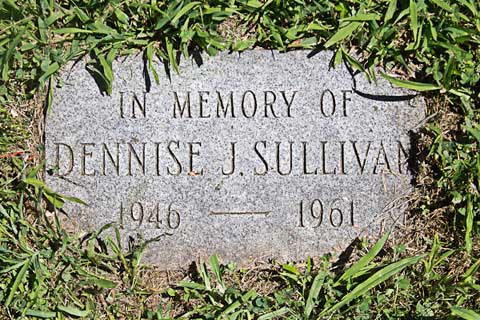
https://www.canyoncountryzephyr.com/2022/05/15/60-years-later-still-searching-for-dennise-sullivan-by-jim-stiles-zx8/

And once more, now that you’ve read the latest Zephyr Extra and waded through the ads, please take a minute to comment. Thanks for your support…. Jim Stiles

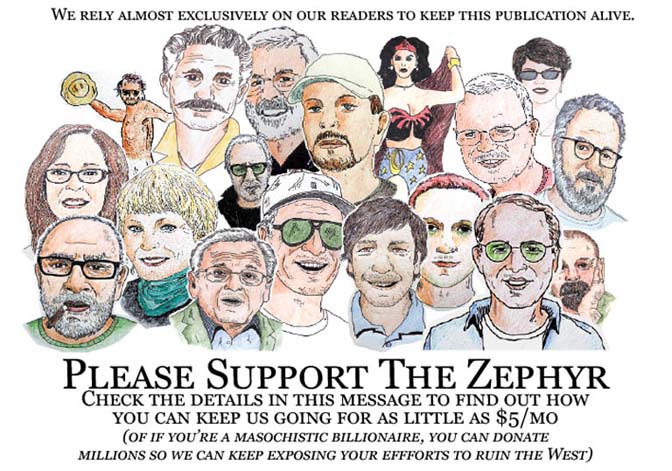
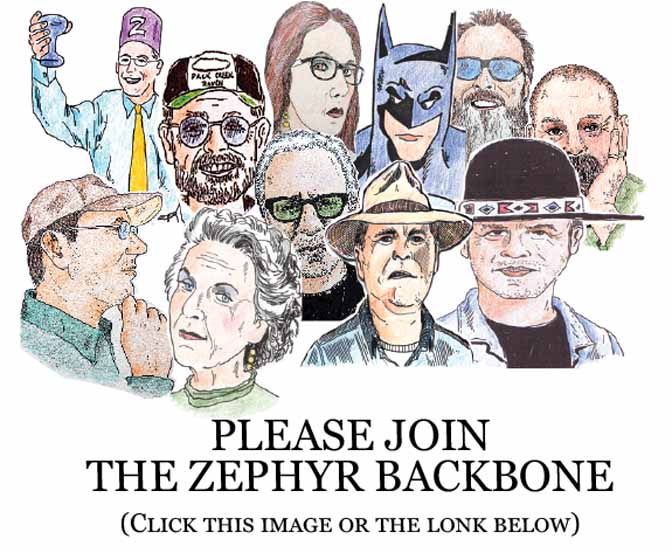
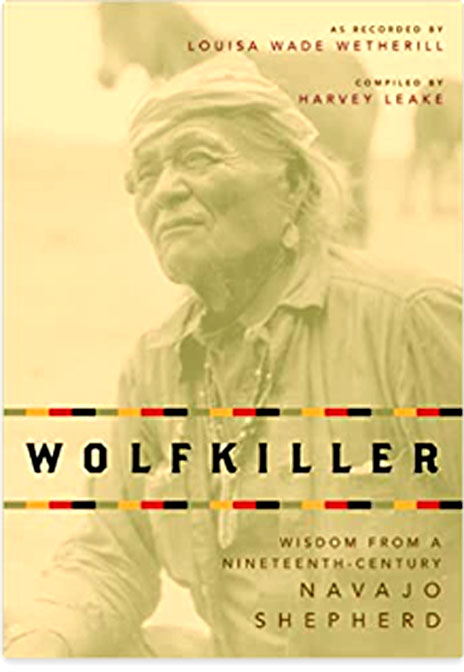


Super cool; love the photos. You left out Perfecto Martinez and the naked lady glyphs north of Salt Valley, but I can certainly forgive you that! Many years ago, Robin and I visited the famous Buckhorn Panel in the Swell and noted the names Jim Bridger and Bill Jackson carved prominently over-top of ancient art. Another case of ancient art defaced by graffiti that I thought had historical value in and of itself. We hiked up Cow Canyon on that trip, up to a huge grotto on the side of the canyon where I had seen a boulder with a beautiful spiral etched upon it. When we got up to the grotto, we saw that “Ken” had scratched his name across and on top of the spiral! Damn you Ken! Plenty of places to make a tasteful graffito without destroying ancient art. To me, that was criminal. We revisited the Buckhorn Panel a few years ago and I began to doubt my own veracity. Where was Jim Bridger and and his buddy Bill? Turns out a restoration society had “restored” the Buckhorn Panel and wiped them out. For me, that illustrated the very conundrum you explored in this essay.
Actually I didn’t leave them out. I had them scanned and ready to go, but I had so many images I’ve been worrying that I might blow out my band width…I’m saving them for “volume 2.”
It occurred to me that this anonymous “Ken” who scratched over an ancient spiral… No way was it your old pal Ken Sleight. Hope his spirit got a laugh out of my “damn you Ken!” comment.
Ken Sleight’s spirit is alive and kicking as of yesterday
Another phenomenal issue of the Zephyr!! And the indicated other stories are amazing too. You’re an artist of the pen! Thank you for preserving both pictures and information. These examples of “graffiti” are unlike the modern ones which really are destructive! Why does anyone want to destroy the old drawings and figures, is beyond me. But it’s the same even here in Nevada where at our Red Rock Canyon graffiti is a problem. At one area East of U. S. 95 South someone threw old tires onto Indian heirogliphics then set them on fire so the melted rubber ran down, completely destroyed the ancient artwork!! (Sorry about the misspelling!)
Rock art–or rock graffiti–whatever the beholder interprets it to be, has changed as the motives of artists–vandals–have changed, most notably in last 5 decades.
For centuries it was used as a primitive journal of life for the Ancients; hunts, harvests, celestial events, sacred things, and perhaps humorous things. We will never know but I lean towards the belief that the Ancients lived very complex social and personal lives.
The Explorers, cowboys, sheepmen and prospectors who inscribed names and dates were tracing their journeys, and leaving–for all that they knew–what could have been a final message to the world. Cowboys and sheepmen were likely marking the trails and locations of seasonal cow and sheep camps. Without regulated grazing, moving livestock across the range could be a contentious and sometimes deadly business. I figure they were doing the best they could to establish a given territory to which they would return each year.
And then you have the lonely, eccentric souls who live out their fantasies in stone carvings to mystify the generations of come. There is power in mystery, and men like Aharron Andeew still hold power of the captivated minds of those wondering over his bas relief.
But now, it seems, narcissism is the driving motive behind rock graffiti–genuine vandalism. There is the case of a young woman who in 2017-18 left her trademark illustrations on rocks throughout Utah’s “Mighty Five” and scores of other national parks and monuments. She was defacing the landscape for Instagram likes. Nothing more. Not history. No tracing of important trails. No marking of disputed territory. Narcissism.
That being said, having grown up in the shadow of the La Sal Mountains, I gouged a few innocent quakie trees with my initials–and maybe those of some childhood crushes–and not a few hearts.
Thank you, Jim!
The word vandal originally meant “wanderer,” and was associated with an ancient Germanic tribe who sacked Rome in 455AD, shortly before its ultimate demise. It wasn’t until more than a thousand years later that the word came to mean “destroyer of beautiful things.”
So, by the original definition, all of us who love to wander, are vandals. By the later definition, if we consider natural features to be beautiful, any person who changes their aesthetic, is a vandal. You could even extend the definition to say that anyone who destroys a piece of a beautiful landscape to build a structure or log a forest or turn a beautiful piece of desert into a mining town, that mars the view, is a vandal.
The question is really not one of vandalism. Most of what humans do in beautiful natural places qualifies as such. What was done is done. The real question is when to stop vandalizing, or, in other words: how much beauty we want to leave for future generations. That is the point at which all vandalism, by all definitions: whether carving names or religious icons on a rock, or building a McMansion on a hillside, should stop.
I once came upon the most amazing carvings on giant old aspen trees done by Basque sheepherders. Along with the requisite naked ladies found there were also some beautiful faces of both genders.
Just wondering if the word ‘NEMO’ would be considered vandalism or historic art.
To me it’s history…one of those cryptic clues to the fate of Everett Ruess.
It’s not an either/or. When Ruess made the carving he was 20 years old. It’s unlikely he thought of himself as a historically significant figure leaving an important legacy. So, at least according to his state of mind, he committed an act of vandalism. If we make the distinction in hindsight, then we can’t really condemn anyone for marring anything just because there’s a chance it might become significant in some distant future.
Recently returning from Cortez Co I looked at the Blue mountain with all those windmills. To me that area is less beautiful and has been vandalized.
Yeah. No way that was my buddy Ken Sleight. He revered the old rock art and even the cowboy inscriptions. Sleight discovered one of the early “Nemo” quote left by Everett Reuss.
Totally agree, and unfortunately there will be many more of them throughout our nation. No more opportunities of taking a great photo of some beautiful scenery without one of these beast standing in the way of the perfect photo.
Clearly all Stephen Mather’s paved roads and tunnels he built through the national parks are vandalism. (Or are they? Any exceptions?) Going to the Sun Highway in Glacier? The tunnels entering Zion? Trail Ridge Road, gouged through the tundra in Rocky Mountain National Park, amongst all the warnings not to walk on the tundra? Is beauty a defense? I’ve had folks tell me Lake Powell is beautiful.
Dams? Hetch Hetchy, Glen Canyon, Gran Cooley, etc. Sure why not?
Are sheep or cows set loose on wilderness vandals? or do they lack the intent? (Hooved Locusts, John Muir called sheep.)
Are battlefield monuments too official to be vandalism? What is this “hallowing,” anyway? Are visits to salvage the Titanic site out to vandalize? Tourists with cameras and little guidebooks at the Little Big Horn or Gettysburg? All those bodies of indigenous ancestors racked up in the Smithsonian? plunderers as vandals . . .
The one I puzzle over is: Is Mount Rushmore vandalism? Can you do “art” with dynamite? How about all those Christo stunts, like the orange curtains in Rifle Gap?
This word Vandalism can be slippery. But I find it useful as a critical dysphemism anyway. Good meditation on the act of vandalizing, Jim. And lots of relevant cases to show us. Holy denis julien Batman! Didn’t JW Powell leave some carvings in and about Glen Canyon–Music Temple I think? . . . we’re waiting for Installment #2.
I can understand someone in the unexplored wilds and back country of anywhere back in the day wanting to leave their mark and date which might become valuable to historians at a later date.
What I can’t understand is superimposing graffiti of any kind on ancient prehistoric petroglyphs or pictographs and destroying that history in the process.
If you’re talking about contemporary vandalism that destroys ancient rock art like the Moab Panel, I couldn’t agree more. But I hope you’re not talking about the Julien inscription in 1844. If so, then that would place you in the same camp as those demanding the removal of statues by Abraham Lincoln and especially Thomas Jefferson. No doubt both men held views that would be appalling in 2023. We have to look at history with a nuanced and perhaps forgiving eye. Let’s consider recent history. In 2008, Barack Obama publicly opposed gay marriage. Years later he stated that his views on the subject were “evolving.” Do we condemn him for opinions he once defended?
I have always wondered how many of the ancient works we see might not have been made for noble purposes. I try to avoid the conceit that modern people are substantially different from the ancients, and can’t help but imagine a bunch of teens out doing what teens do, and as part of that they paint some fun and rude figures on a rock wall. Their contemporary adults were annoyed; now we over-interpret.
Jim, this was a particularly brilliant edition of your traditionally superb research and wordsmithing; thank you! It reminds me of a conundrum I have considered for years. Here is the scenario: I hike along and toss my empty tuna can into the sagebrush. A ranger sees me and gives me a ticket for littering and bags and tags the can for potential evidence. Not learning from this, on a subsequent hike I throw my broken pocketknife into the bush, but this time no ranger sees me. Fifty years later my grandson hikes the same trail, sees the now rusty pocketknife, picks it up and pockets it. A ranger sees this (maybe the granddaughter of the ranger who cited me a half-decade earlier) and cites my grandson for thieving a historic artifact. Interesting, eh? Thanks again–keep up your good work, Jim.
Two years ago, the Birthing Rock petroglyphs were vandalized west of Moab. The Bureau of Land Management did a great job to clean off the profanities that were written on the rock. Some person knew how to erase the graffiti without damaging the rock or petroglyphs. In like manner, the Park Service should hire a talented artist to recreate the Moab Panel the same way it was created in the first place. There may be reasons why the Park Service would not want to recreate the site, however, there are greater reasons why they should. If they can recreated the Wolf Ranch log cabin, they can recreate the pictograph panel. I will pursue this suggestion and see where it goes. With a little backing from others, maybe this idea can do some good. What a few vandals took away from the world in 1980, doesn’t have to be permanent.
I’m not a big fan of historic graffiti, but accept it as a record of the first (or at least early) explorers/settlers. However I see a BIG difference between what the ancestral indigenous people did, or even the very early explorers/settlers, compared to modern graffiti. When they made their marks, there were not over 7 BILLION people on the earth. Indigenous people made rock symbols to communicate with their spirits or make culturally significant, meaningful marks. They did NOT self-aggrandize themselves by writing, “Barbie was here.” Further, today we have cameras, the internet, Facebook, Instagram and a jillion ways to record one’s presence at a site. LEAVE NO TRACE. Unlike the dumbass who recently carved his name on the wall of the Colosseum–just cuz he thought it was a cool thing to do. On the other hand, social media has caused a tidal wave of visitors to natural areas and that’s a sad thing, too.
Out near Chicken Corners (across the river from Dead Horse Point) my dad and a couple of his siblings carved their names into the sandstone wall to mark the spot where their father, Joseph Hills Johnson died in a tragic horseback riding accident. At that time there were few tourists and no rules against such actions. We, their children and grandchildren, view their inscriptions as historic. A small marker has been erected by some family members to pay tribute to our grandfather, who was a deputy sheriff at the time of his death. My father was born three months after he died.
A very well done article, Jim (as always)!
I agree with you completely, Gemie. Thanks for that little piece of history.
Back in the 1980’s, while I was a seasonal “range technician” for the Vale district of the BLM in SE Oregon, I was directed to deal with spray painted graffiti inside a lava tube cave in the Tire-Tube Lava Field just north of Burns Junction, Oregon. The tube was located about 13 miles west of Rome where I was stationed as the Owyhee River ranger. This job fell under the “other duties as assigned” passage in my official Job Description. The good news was that I had an official reason to explore the Tire-Tubes which I’d never had an opportunity to visit. The bad news was that I was directed to SPRAY PAINT over the inscriptions which dated back to the 1930’s and may have been inscribed by members of some secret society(?) that held meetings in the caves. After locating & checking out the offending graffiti I told my boss that I was leery of the possible ill effects of employing the many needed cans of “BLM Brown” spray paint in such a tightly enclosed, poorly ventilated space. It couldn’t possibly be good for whatever critters may be living (or just visiting, as was I) down there. Fortunately, I was supervised by a guy that agreed with my assessment. Unfortunately, his boss did not. Jerry got us out of our jam by hemming & hawing until upper management became diverted onto the next “serious” problem that required immediate attention and, as far as I know, the job, as described, has never been completed.